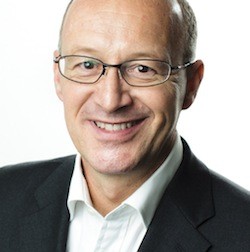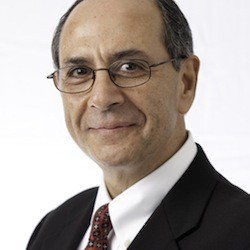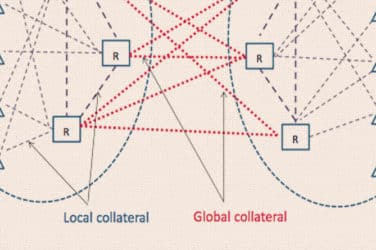Beset by high costs of capital, regulatory change, and possibly the worst economic environment in decades, major banks and brokerage houses are scrambling to rationalize their cost structures and redefine themselves in the post-financial crisis era. Much of that redefinition is geared toward streamlining operations as well as procurement. “We are seeing a massive contraction in the number of systems that institutions will have in their data centers,” said Peter Banham, segment vice president and head of strategy for SunGard’s capital markets business. “Larger institutions, in particular, are actively engaged in identifying technologies, services or processes that can be consolidated, outsourced or subcontracted.”
“We are seeing a massive contraction in the number of systems that institutions will have in their data centers.” Peter Banham

Peter Banham, segment vice president and head of strategy for SunGard’s capital markets business
One SunGard client has 900 systems servicing its investment-banking infrastructure, provided by 100 different vendors, Banham noted. “They want to reduce those numbers by two-thirds within the next two years, with no more than 20 vendors and focus on five core vendors, including SunGard,” he said.
SunGard, based about 13 miles outside Philadelphia in Wayne, Pennsylvania, is the largest privately held software and services company, and was ranked #434 in the 2011 Fortune 500. Formed in 1982 as a computer-services spin-off from Sun Oil Company, SunGard was publicly traded from 1986 to 2005, when it was taken private in a leveraged buyout.
Built up largely through more than 160 acquisitions since 1986, SunGard is comprised of four business units: Availability Services, Financial Systems, K-12 Education, and Public Sector. SunGard’s capital markets business, with $1 billion in annual revenue, accounts for 40% of Financial Systems revenue, more than the next two largest segments — asset management and wealth management — combined.
SELL SIDE
At the core of capital markets are the major sell-side institutions, such as Goldman Sachs, Morgan Stanley, and Bank of America Merrill Lynch. Via executing and clearing brokerage businesses, the firms pump funds from one end of the market to another.
“Whether it’s corporations, governments or retail borrowers trying to raise capital, or retail and institutions trying to invest, banks and securities are at the center, where they in effect manufacture capital,” Banham said.
According to SunGard, 43 of the world’s 50 largest banks use SunGard’s capital markets products, and more than 2,000 buy-side firms and 530 brokers are connected via the SunGard Global Network, which is designed to serve as a financial ecosystem.
“By using SGN to source new liquidity, we’ve been able to automate workflow, lower costs and increase revenue,” said Keith Babbitt, managing director and head of global securities finance a t Kn i ght Clearing Services.
Added Banham, “SGN is not just about connectivity to execution venues. It’s a global infrastructure, connecting our buy-side and sell-side customers directly.”
Like the industry it serves, SunGard is undergoing a transformation. Its capital-markets businesses, which as recently as last year operated in four separate business lines, have been consolidated.
“Over the last eighteen months, all of those disparate capital-markets businesses across SunGard have been merged into a single segment,” Banham told Markets Media.
“We were treating each of these areas as individual silos within an investment bank or capital-markets trading institution,” he continued. “Although some customers today still look at FX, equities, fixed income and commodities as distinct businesses that are serviced by different IT solutions, many are consolidating.”
Viewpoints vary as to whether trading and investment firms should silo asset classes or group them together, and Wall Street seems to move in cycles with regard to which direction it is moving on this front. But in the current market of low trading volumes and profit margins under pressure, the trend is decidedly towards amalgamating desks.
Banham, an ex-trader, acknowledges that SunGard sometimes faces a corporate identity challenge, as it has almost 20 separate brands used by 3,000 capital markets firms globally. Stream GMI, an accounting-software product for clearing and settling listed futures and options, has been around for about 20 years, so it has its own product identity and brand awareness. “
A lot of people associate us with only a single brand name or just a product name attached to it, not the full range of solutions we provide,” Banham said. “I expect the number of product brand names to decrease over the next few years as we clarify our mission.”
Banham said that mission is to have clients, by 2015, recognize SunGard as the leading global provider of “transformative single-platform technology solutions in the capital markets.”
“We are at the point, following all the acquisitions that I’ve been involved with during my 13 years at the company, that customers are looking at their capital markets business and (they) need innovative technology solutions,” said Banham. “No matter what the problem within a capital markets institution, SunGard has a range of solutions, or a single solution.”
Those “solutions” fall into three large sectors, corresponding to the services that banks provide to their institutional and retail customers: trading, risk and position control; securities finance and collateral; and post-trade operations. As befitting a services company of SunGard’s heft, product offerings include soup-to-nuts offerings, whereas smaller competitors more typically focus on specific parts of the trade cycle. “We are providing infrastructure and services to banks, securities houses, and broker-dealers from execution to settlement, and everything in between,” said Banham.
SIMMERING TREND
Current trends on Wall Street are not a knee-jerk reaction to the troubled market conditions of 2012; rather, they are a byproduct of longer-term, seismic changes. At a strategy meeting of SunGard executives a few days after the September 2008 collapse of Lehman Brothers, Banham said he predicted that banks would adopt a back-to-basics approach, foregoing financial wizardry for customer service, a view that has since been borne out.
“Banks have stopped looking at innovating highly complex products,” he said. “The focus has shifted from product innovation to client-service innovation. How can you give customers access to more markets and create more leverage for them to trade? How can you better service and settle?”
That redrawn want list has boosted demand for technology and automation. “Until Lehman, most meetings involved me sitting with senior traders or heads of operations, where they would ask me help them make more money through more complex products or pricing algorithms,” said Banham. “Post-Lehman, the focus has shifted to saving money by automating pre- and post-trade processes.”
In keeping with its goals of organizing its capital-markets products along the lines used by its bank customer, SunGard targeted four major themes affecting its clients: managing the cost of capital, improving client services, controlling operational costs, and managing regulatory change.
“In setting our priorities, we are asking in what areas we should increase innovation and investment, rather than having a range of solutions, each addressing tactical needs,” Banham said.
In the current belt-tightening environment, it’s not a surprise that managing the cost of capital is at the top of the list of priorities for both SunGard and its clients.
“Return on capital is the most important business driver for our capital markets customers,” said Banham. “Basel III will significantly impact the return on capital, and asset classes that our clients and their customers invest in will be significantly impacted. The cost of holding certain derivatives in a portfolio will double; firms are adapting and changing their business models accordingly.”
Banham noted Credit Suisse’s merging of its private banking and investment banking operations from both a front and back-office perspective.
“Credit Suisse is a good example of the walls being broken down between what were traditionally standalone businesses, which operated autonomously in terms of technology platforms,” said Banham. “Whether you’re settling and clearing an instrument in investment banking or private banking, those post-execution services are effectively the same.”
“By using SGN to source new liquidity, we’ve been able to automate workflow, lower costs and increase revenue.” Keith Babbitt, managing director and head of global securities finance at Knight Clearing Services
Regulatory change in the form of Dodd-Frank in the U.S. and Emir in Europe is also having a major impact on back-office operations, which traditionally have been asset-class specific.
“For the first time, post-trade systems for OTC derivatives, cash securities and listed futures and options can no longer act in separate silos,” Banham said. “Consolidation for both cost and efficiency is inevitable.” “Some customers will close down their listed futures and options back offices and centralize everything into what is currently OTC securities post-trade operations,” he continued. “We also have customers doing the exact mirror image: they are going to close down their cash and OTC securities operations areas, and create a single post-trade operations area within what is currently listed futures and options.”
SWAP DEFINED
As just one example of a headache inducing regulatory change that is prompting capital-markets firms to streamline their operations and business structures, the U.S. Commodity Futures Trading Commission and the U.S. Securities and Exchange Commission in June approved the definition of a swap and security-based swap rule that will trigger compliance deadlines for about 20 Dodd-Frank measures including filing, trade reporting, clearing, position management and record-keeping for the $650 trillion global swaps industry.
Although many industry participants expect an adoption period to complete the standardization, automation and processing of numerous swap products, regulators are expecting compliance within the declared timelines. As a result, industry participants will continue to experience “significant pressure on swap-trading operating costs in front, middle and back office,” said Ed Elgerzawy, partner at SunGard Global Services.
“Firms need to incorporate both tactical and strategic approaches to improving their operation and technology platforms to meet Dodd-Frank regulations.” Ed Elgerzawy

Ed Elgerzawy, partner at SunGard Global Services
Those costs include client and third party connectivity, initial and variation margin, central clearing, collateral management, counterparty risk, limits management, position management, data retention, record keeping, and compliance reporting.
This definition of a swap accelerates the race for industry participants focusing on improving the automation of their entire straight-through processing of OTC swap trading life cycle. “We believe that firms need to incorporate both tactical and strategic approaches to improving their operation and technology platforms to meet Dodd-Frank regulations within a tight time frame,” said Elgerzawy.
“Balancing tactical and strategic implementations is better achieved through the creation of an effective future state roadmap of the swap industry environment,” he added.
With Dodd-Frank and Emir set to drive a significant amount of OTC derivatives onto electronic platforms that will be cleared by central counterparties, banks and their corporate customers are faced with collateral-management issues for swaps portfolios.
The impact of new legislation on collateral management is likely to be immediate and deeply felt. The need to manage collateral on cleared trades will result in significant changes to operational processes, and initial margin requirements by CCPs will decrease the amount of high-quality collateral in circulation.
SunGard has invested heavily in collateral management, said Banham, “whether it’s helping outright traders simply see the capital transfers against their positions, or a (Credit Valuation Adjustment) or collateral desk to more effectively use the collateral at their disposal, or helping an institution to optimize collateral on an enterprise basis.”
From an trader’s perspective, collateral management is addressed by SunGard via its Front Arena cross-asset position control system, which handles front office needs of basic collateral in its trading books.
At the enterprise level, SunGard’s Apex Collateral is the specialist collateral trading and management suite, handling full front-to-back collateral needs. Within this suite, Apex Optimizer provides numerical optimization algorithms to minimize cost of collateral and maximize return on assets.
“Apex started out being used in securities finance, which tended to be where most people thought of collateral management,” said Banham. “We have evolved it into an enterprise infrastructure for collateral management.”
The Apex Optimizer engine surveys collateral requirements and the inventory of available assets in order to find the mathematically optimal allocation of collateral assets to requirements. Spurred by new regulations, banks are launching services aimed at simplifying the collateral process in order to help clients avoid the associated funding costs and increased complexities.
“SunGard’s Apex Collateral solution helps us increase our effectiveness by providing a consolidated, big picture view of our collateral asset pool across OTC derivatives, reinsurance collateral, repo and securities lending,” said Rich Hochreutiner, global head of collateral trading and management at reinsurer Swiss Re. This transparency “helps us mitigate counterparty risk while getting maximum value from our collateral assets,” Hochreutiner said.
The discussion of unintended consequences will now move quickly into real-world examples and allow the regulators and industry participants to adjust accordingly.
“This is an important and crucial phase of any large-scale regulatory change,” Jeffrey Wallis, managing partner at SunGard Global Services, said in late July. “The stark realities of the businessmodel changes, technology and operations requirements will be realized by industry participants over the next 60 days as they plan the full implementation of Title VII within their companies.”





